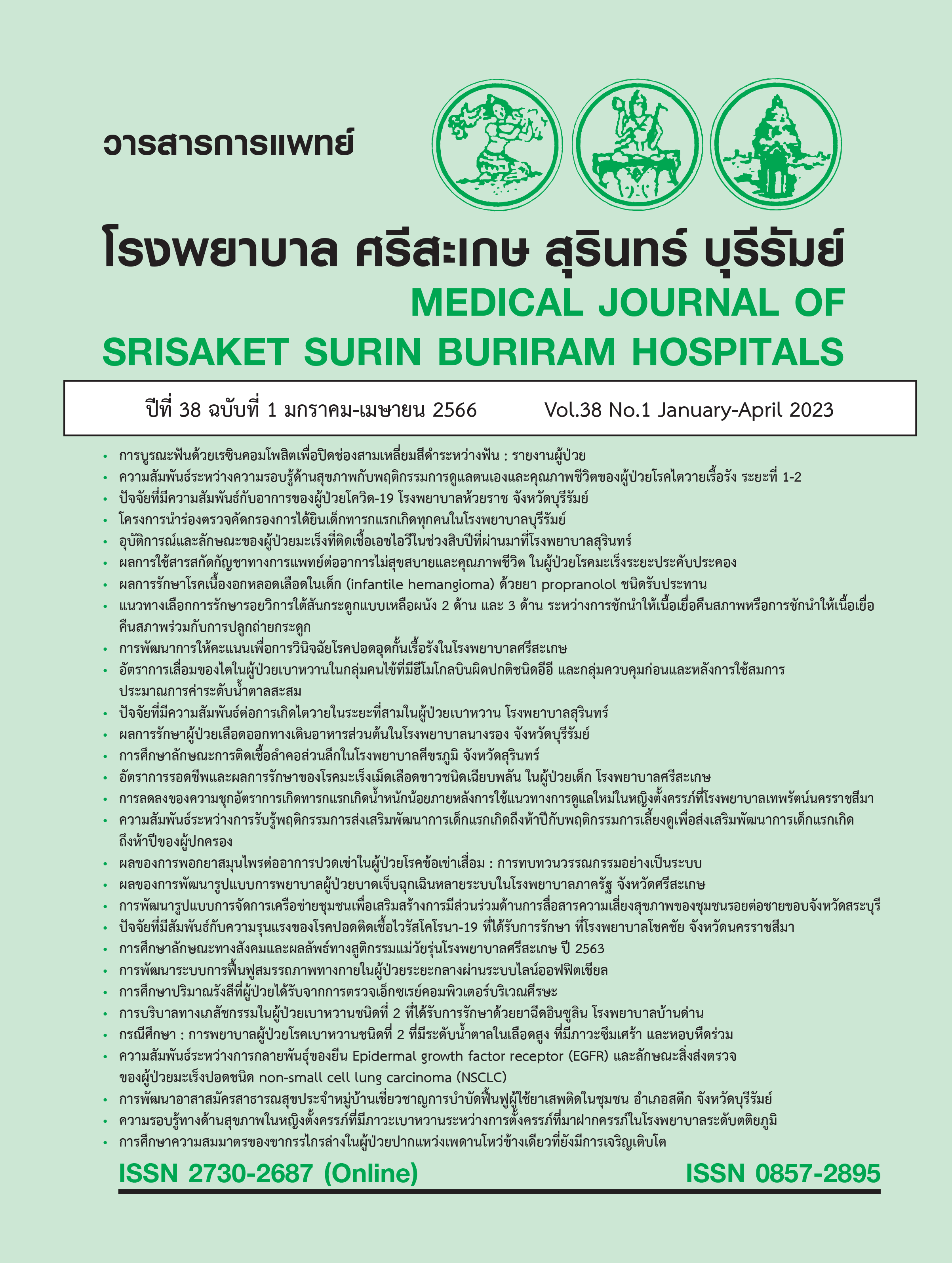ความสัมพันธ์ระหว่างการกลายพันธุ์ของยีน Epidermal growth factor receptor (EGFR) กับข้อมูลพื้นฐานของผู้ป่วยและลักษณะสิ่งส่งตรวจ ของผู้ป่วยมะเร็งปอดชนิด non-small cell lung carcinoma (NSCLC)
Main Article Content
บทคัดย่อ
หลักการและเหตุผล: โรคมะเร็งปอดเป็นมะเร็งที่มีอัตราการเสียชีวิตมากที่สุดของประชากรทั่วโลก ชนิดของมะเร็งปอดที่พบมากที่สุด คือ non-small cell lung carcinoma (NSCLC) ปัจจุบันพบว่าการรักษาแบบมุ่งเป้าด้วยการให้ยา EGFR-tyrosine kinase inhibitors (EGFR-TKIs) ในผู้ป่วย NSCLC ระยะลุกลามที่มีการกลายพันธุ์ของยีน EGFR นั้นให้ผลดีและช่วยเพิ่มอัตราการรอดชีวิตได้ ส่วนใหญ่จะตรวจพบความผิดปกติทางพันธุกรรมของยีน EGFR ในผู้ป่วยเพศหญิง อายุน้อย และไม่มีประวัติสูบบุหรี่
วัตถุประสงค์: เพื่อศึกษาความสัมพันธ์และหาตัวแปรที่มีผลระหว่างการกลายพันธุ์ของยีน EGFR กับข้อมูลพื้นฐานของผู้ป่วยและลักษณะของสิ่งส่งตรวจในผู้ป่วยที่ได้รับการวินิจฉัยว่าเป็นมะเร็งปอดชนิด NSCLC ที่เข้ารับการรักษาในโรงพยาบาลสุรินทร์
วิธีการศึกษา: เป็นการศึกษาแบบ Retrospective observational case-control study โดยการทบทวนเวชระเบียน รายงานชิ้นเนื้อ และผลย้อมพิเศษทางอิมมูโนวิทยาชนิด Thyroid transcription factor 1 (TTF-1) ของผู้ป่วยสัญชาติไทยและมีภูมิลำเนาอยู่ในจังหวัดสุรินทร์ทุกรายที่ได้รับการวินิจฉัยว่า เป็นมะเร็งปอดชนิด NSCLC ที่ส่งตรวจในโรงพยาบาลสุรินทร์ ระหว่างวันที่ 1 มกราคม พ.ศ 2560 ถึง 31 ธันวาคม พ.ศ. 2564 โดยใช้การคำนวณสถิติเชิงพรรณนาคือ ค่ากลาง ค่าเบี่ยงเบนมาตรฐาน ค่าต่ำสุด-สูงสุด และร้อยละ แล้วหาตัวแปรที่สัมพันธ์กับการกลายพันธุ์ของยีน EGFR โดยใช้สถิติเชิงอนุมานด้วยการคำนวณ logistic regression analysis
ผลการศึกษา: จากการทบทวนรายงานของผู้ป่วย 189 ราย พบว่าร้อยละ 55.6 มีการกลายพันธุ์ของยีน EGFR โดยส่วนใหญ่เป็นตำแหน่งที่ 19 (ร้อยละ 58.1) สิ่งส่งตรวจส่วนใหญ่เป็นชิ้นเนื้อ (ร้อยละ 90.4) ที่ได้จากหัตถการผ่าตัดชิ้นเนื้อเพื่อวินิจฉัย (ร้อยละ 84.1) และมาจากปอดหรือหลอดลมเป็นส่วนใหญ่ (ร้อยละ 53.4) ชนิดของมะเร็งที่วินิจฉัยมากที่สุดคือ adenocarcinoma (ร้อยละ 70.0) และพบว่าตัวแปรที่มีความสัมพันธ์กับการกลายพันธุ์อย่างมีนัยสำคัญทางสถิติคือสิ่งส่งตรวจที่ได้รับการวินิจฉัยว่าเป็น adenocarcinoma มากกว่ากลุ่มอื่นถึง 6.97 เท่า [OR=6.97, 95% CI (2.14-22.73), p<0.001] เป็น สิ่งส่งตรวจจากปอดหรือหลอดลมมากกว่าตำแหน่งอื่น ๆ 4.35 เท่า [OR=4.35, 95% CI (1.78-10.64), p=0.003] และการแสดงผลบวกทางการย้อมพิเศษอิมมูโนวิทยาTTF-1 มากกว่าผลลบ 4.08 เท่า [OR=4.08, 95% CI (1.19-13.92), p=0.018] ทั้งนี้ผู้ป่วยเพศหญิงที่จะพบการกลายพันธุ์มากกว่าเพศชาย [OR=2.75, 95% CI (1.51-5.02), p=0.001] และเป็นผู้ป่วยที่ไม่มีประวัติสูบบุหรี่มากกว่าผู้ที่สูบบุหรี่ [OR=2.39, 95% CI (1.27-4.52), p=0.016]
สรุป: การกลายพันธุ์ของยีน EGFR มีความสัมพันธ์อย่างมีนัยสำคัญทางสถิติกับผู้ป่วยเพศหญิง ไม่มีประวัติการสูบบุหรี่ สิ่งส่งตรวจจากปอดหรือหลอดลม ที่ได้รับการวินิจฉัยว่าเป็น adenocarcinoma และการแสดงผลบวกทางการย้อมพิเศษอิมมูโนวิทยา TTF-1
Article Details

อนุญาตภายใต้เงื่อนไข Creative Commons Attribution-NonCommercial-NoDerivatives 4.0 International License.
เอกสารอ้างอิง
Torre LA, Bray F, Siegel RL, Ferlay J, Lortet-Tieulent J, Jemal A. Global cancer statistics, 2012. CA Cancer J Clin 2015;65(2):87-108. doi: 10.3322/caac.21262.
สุพัตรา รักเอียด, ศุกล ภักดีนิติ, วิษณุ ปานจันทร์, อาคม ชัยวีระวัฒนะ, วีรวุฒิ อิ่มสำราญ, บรรณาธิการ. แนวทางการตรวจวินิจฉัยและรักษาโรคมะเร็งปอด (ปรับปรุงครั้งที่ 2). กรุงเทพฯ : โฆษิตการพิมพ์ ; 2558.
Borczuk AC, Chan JKC, Cooper WA, Dacic S, Kerr KM, Lantuejoul S, et al. Tumours of the lung. In : The WHO Classification of Tumours Editorial Board. WHO Classification of Thoracic Tumors. 5th ed. Lyon : International Agency for Research on Cancer ; 2021:19-36.
Chang JT, Jeon J, Sriplung H, Yeesoonsang S, Bilheem S, Rozek L, et al. Temporal Trends and Geographic Patterns of Lung Cancer Incidence by Histology in Thailand, 1990 to 2014. J Glob Oncol 2018;4:1-29. doi: 10.1200/JGO.18.00013.
Cheng L, Alexander RE, Maclennan GT, Cummings OW, Montironi R, Lopez-Beltran A, et al. Molecular pathology of lung cancer: key to personalized medicine. Mod Pathol 2012;25(3):347-69. doi: 10.1038/modpathol.2011.215.
Mok TS, Wu YL, Thongprasert S, Yang CH, Chu DT, Saijo N, et al. Gefitinib or carboplatin-paclitaxel in pulmonary adenocarcinoma. N Engl J Med 2009;361(10):947-57. doi: 10.1056/NEJMoa0810699.
Musayeva M, Sak SD, Özakıncı H, Boyacıgil Ş, Coşkun Ö. Evaluation of epidermal growth factor receptor mutations and thyroid transcription factor-1 status in Turkish non-small cell lung carcinoma patients: A study of 600 cases from a single center. Turk Gogus Kalp Damar Cerrahisi Derg 2020;28(1):143-50. doi: 10.5606/tgkdc.dergisi.2020.18196.
Graham RP, Treece AL, Lindeman NI, Vasalos P, Shan M, Jennings LJ, et al. Worldwide Frequency of Commonly Detected EGFR Mutations. Arch Pathol Lab Med 2018;142(2):163-7. doi: 10.5858/arpa.2016-0579-CP.
Calibasi-Kocal G, Amirfallah A, Sever T, Umit Unal O, Gurel D, Oztop I, et al. EGFR mutation status in a series of Turkish non-small cell lung cancer patients. Biomed Rep 2020;13(2):2. doi: 10.3892/br.2020.1308.
Lindeman NI, Cagle PT, Beasley MB, Chitale DA, Dacic S, Giaccone G, et al. Molecular testing guideline for selection of lung cancer patients for EGFR and ALK tyrosine kinase inhibitors: guideline from the College of American Pathologists, International Association for the Study of Lung Cancer, and Association for Molecular Pathology. J Thorac Oncol 2013;8(7):823-59. doi: 10.1097/JTO.0b013e318290868f.
Tomonaga N, Nakamura Y, Yamaguchi H, Ikeda T, Mizoguchi K, Motoshima K, et al. Analysis of intratumor heterogeneity of EGFR mutations in mixed type lung adenocarcinoma. Clin Lung Cancer 2013;14(5):521-6. doi: 10.1016/j.cllc.2013.04.005.
Villa C, Cagle PT, Johnson M, Patel JD, Yeldandi AV, Raj R, et al. Correlation of EGFR mutation status with predominant histologic subtype of adenocarcinoma according to the new lung adenocarcinoma classification of the International Association for the Study of Lung Cancer/American Thoracic Society/European Respiratory Society. Arch Pathol Lab Med 2014;138(10):1353-7. doi: 10.5858/arpa.2013-0376-OA.
Liu B, Shi SS, Wang X, Xu Y, Zhang XH, Yu B, et al. [Relevance of molecular alterations in histopathologic subtyping of lung adenocarcinoma based on 2011 International Multidisciplinary Lung Adenocarcinoma Classification]. [Article in Chinese]. Zhonghua Bing Li Xue Za Zhi 2012;41(8):505-10. doi: 10.3760/cma.j.issn.0529-5807.2012.08.001.
Sun PL, Seol H, Lee HJ, Yoo SB, Kim H, Xu X, et al. High incidence of EGFR mutations in Korean men smokers with no intratumoral heterogeneity of lung adenocarcinomas: correlation with histologic subtypes, EGFR/TTF-1 expressions, and clinical features. J Thorac Oncol 2012;7(2):323-30. doi: 10.1097/JTO.0b013e3182381515.
da Cunha Santos G, Saieg MA, Geddie W, Leighl N. EGFR gene status in cytological samples of nonsmall cell lung carcinoma: controversies and opportunities. Cancer Cytopathol 2011;119(2):80-91. doi: 10.1002/cncy.20150.
Ma ES, Ng WK, Wong CL. EGFR gene mutation study in cytology specimens. Acta Cytol 2012;56(6):661-8. doi: 10.1159/000343606.
Shanzhi W, Yiping H, Ling H, Jianming Z, Qiang L. The relationship between TTF-1 expression and EGFR mutations in lung adenocarcinomas. PLoS One 2014;9(4):e95479. doi: 10.1371/journal.pone.0095479.
Li W, Niehaus AG, O'Neill SS. Immunohistochemistry Profile Predicts EGFR Mutation Status in Lung Adenocarcinoma. Int J Surg Pathol 2020;28(5):502-6. doi: 10.1177/1066896920909427.
Chen C, Shen D, Li J, Sun Y, Wang J. TTF-1 and EGFR expression are related to EGFR mutation in lung adenocarcinoma. Int J Clin Exp Pathol 2018;11(9):4650-6. PMID: 31949865


